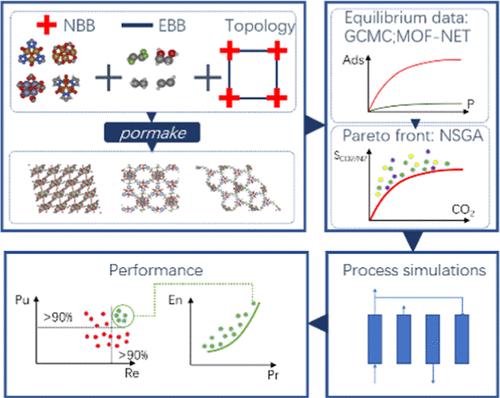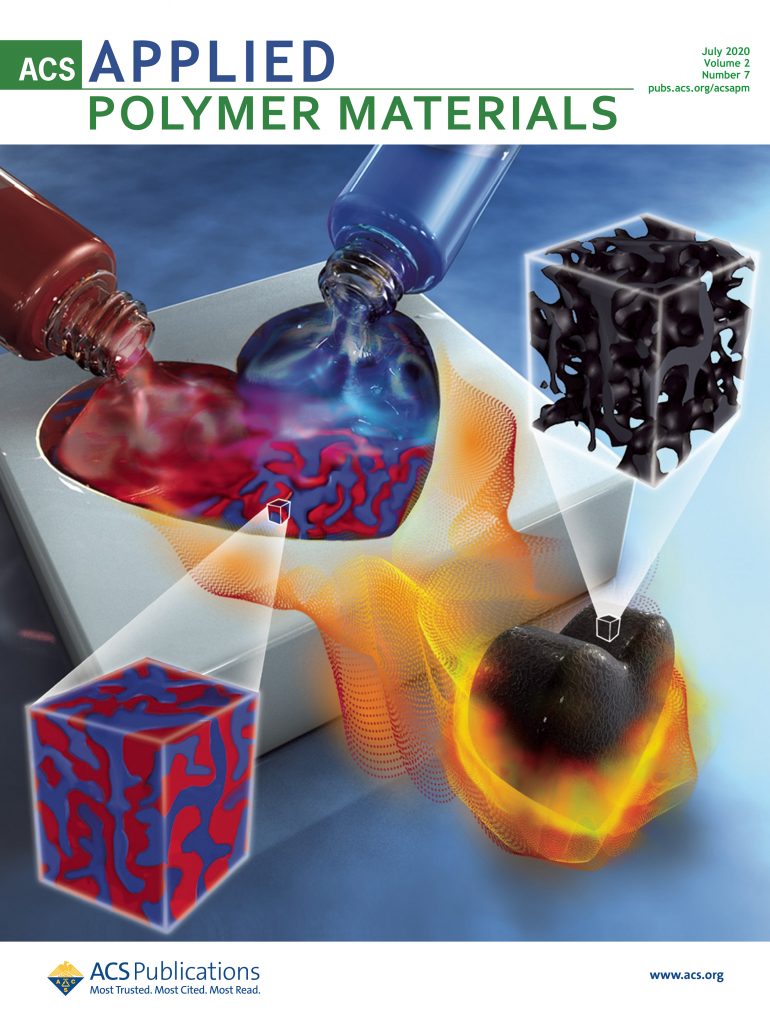利用机器学习和多目标优化对用于碳捕集的金属有机框架进行多尺度计算设计
IF 4.4
2区 化学
Q2 MATERIALS SCIENCE, MULTIDISCIPLINARY
引用次数: 0
摘要
在本文中,我们通过计算设计了一系列针对燃烧后碳捕集进行优化的金属有机框架(MOFs)。我们的工作流程包括:将构件和拓扑结构组合成一组假定的 MOFs 初始集合,使用遗传算法优化这组初始集合以获得高 CO2/N2 选择性,并通过对其在改良 Skarstrom 循环中的性能进行过程级建模来进一步评估顶级材料。我们发现有两组 MOFs 具有优异的工艺性能:一组具有 3-5 Å 的相对较小孔隙,另一组具有 6-30 Å 的较大孔隙。第二组具有较大的孔隙,其结合部位可使 CO2 分子与氧气和多个结构单元的官能团形成多重相互作用,从而产生较高的 CO2/N2 选择性。在采用的工艺模型及其假设条件下,本研究生成的材料大大优于 13X 参考沸石、硅优化离子交换 LTA 沸石和 CALF-20。虽然本研究并不涉及拟议材料的可合成性、稳定性或水相互作用,但它标志着在三个关键领域开发用于碳捕集的实用 MOFs 向前迈出了重要一步。首先,它引入了基于新材料工艺性能的生成工作流程。其次,它确定了用于碳捕集的最佳 MOF 的结构特征,这些特征可作为未来开发的设计指南。最后,许多有前途的材料的潜在存在为一些材料的实验室测试和最终放大提供了希望。本文章由计算机程序翻译,如有差异,请以英文原文为准。

Multi-Scale Computational Design of Metal–Organic Frameworks for Carbon Capture Using Machine Learning and Multi-Objective Optimization
In this article, we computationally design a series of metal–organic frameworks (MOFs) optimized for postcombustion carbon capture. Our workflow includes assembling building blocks and topologies into an initial set of hypothetical MOFs, using genetic algorithms to optimize this initial set for high CO2/N2 selectivity, and further evaluating the top materials through process-level modeling of their performance in a modified Skarstrom cycle. We identify two groups of MOFs that exhibit excellent process performance: one with relatively small pores in the range of 3–5 Å and another with larger pores of 6–30 Å. The performance of the first group is driven effectively by the exclusion of N2 from adsorption, with binding sites able to accommodate only CO2 molecules. The second group, with larger pores, features binding sites where CO2 molecules form multiple interactions with oxygen and functional groups of several building blocks, leading to a high CO2/N2 selectivity. Within the employed process model and its assumptions, the materials generated in this study substantially outperform 13X reference zeolites, in silico optimized ion-exchanged LTA zeolites, and CALF-20. While this study does not address the synthesizability, stability, or water interactions of the proposed materials, it marks a significant step forward in developing practical MOFs for carbon capture in three key areas. First, it introduces a generative workflow based on the process-level performance of new materials. Second, it identifies structural features of optimal MOFs for carbon capture, which can serve as design guidelines for future development. Finally, the potential existence of numerous promising materials offers hope that some may progress to laboratory testing and eventual scale-up.
求助全文
通过发布文献求助,成功后即可免费获取论文全文。
去求助
来源期刊

ACS Applied Polymer Materials
Multiple-
CiteScore
7.20
自引率
6.00%
发文量
810
期刊介绍:
ACS Applied Polymer Materials is an interdisciplinary journal publishing original research covering all aspects of engineering, chemistry, physics, and biology relevant to applications of polymers.
The journal is devoted to reports of new and original experimental and theoretical research of an applied nature that integrates fundamental knowledge in the areas of materials, engineering, physics, bioscience, polymer science and chemistry into important polymer applications. The journal is specifically interested in work that addresses relationships among structure, processing, morphology, chemistry, properties, and function as well as work that provide insights into mechanisms critical to the performance of the polymer for applications.
 求助内容:
求助内容: 应助结果提醒方式:
应助结果提醒方式:


